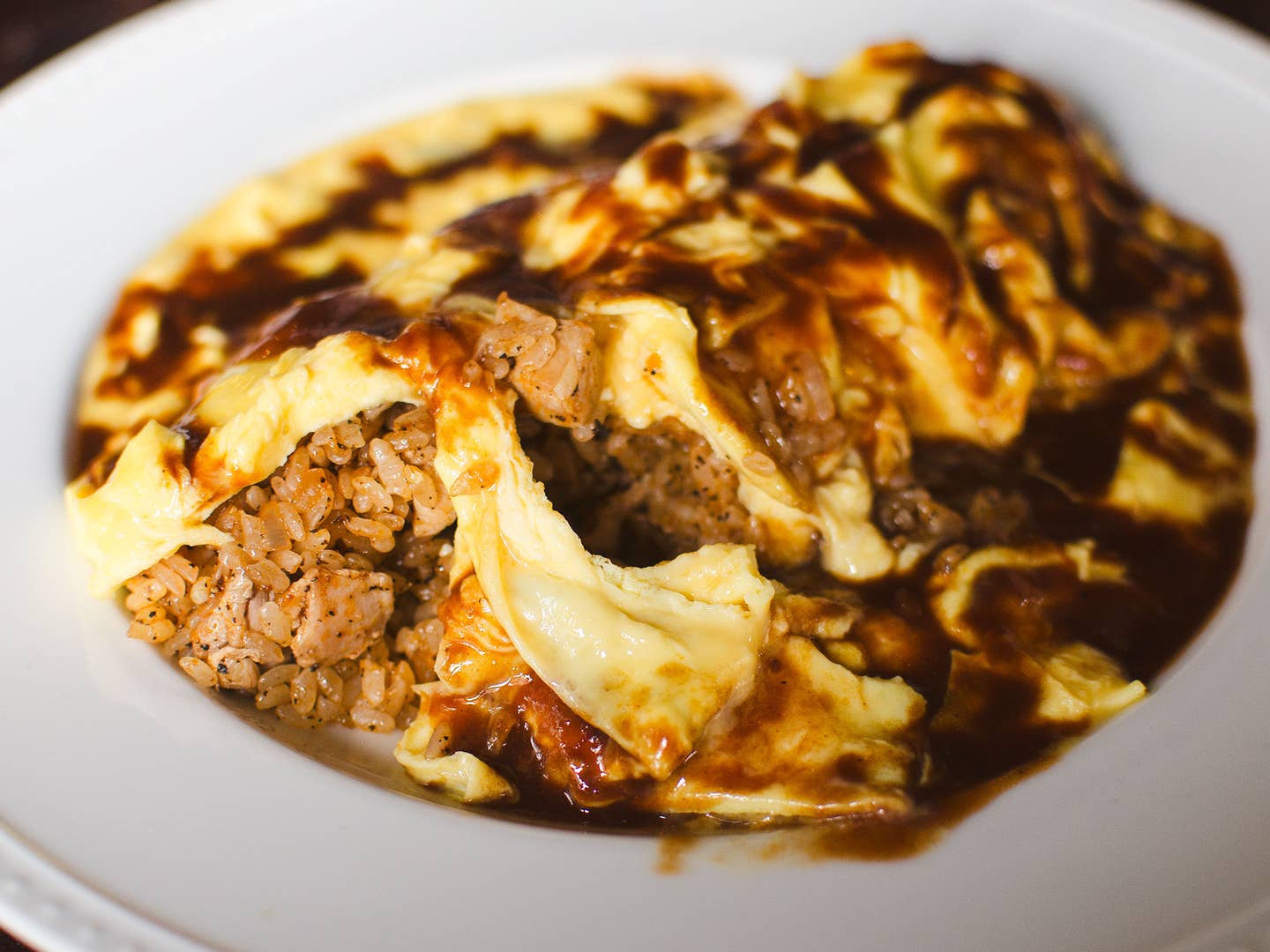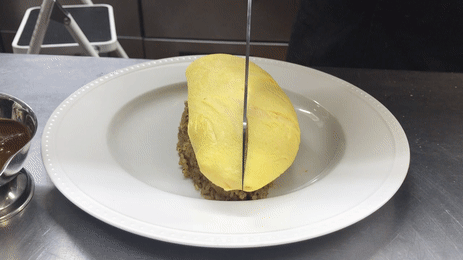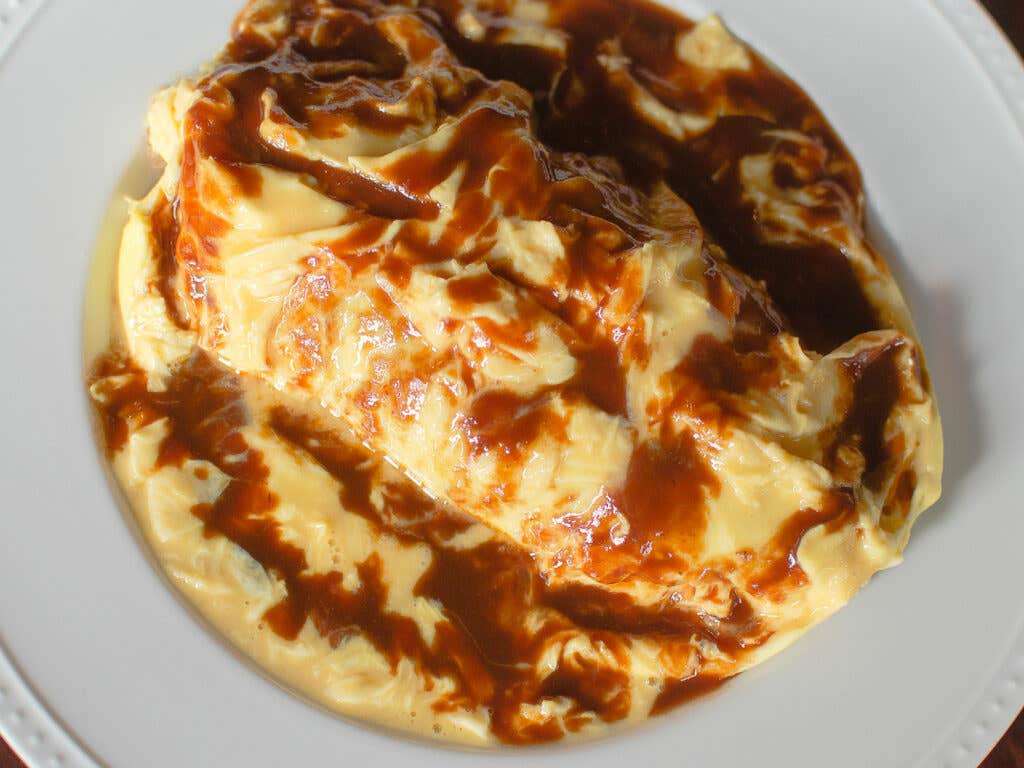
How to Make Omurice, Japan’s Oozy Exploding Omelet
Get to know the home-cooking classic of soft-scrambled eggs with fried rice
Do you remember that scene in Tampopo with the omelet? The one that sits on top of the dish of fried rice and unfurls with custardy egg like a popped balloon when split open?
That’s omurice. (Sound it out and you’ll get the cognate.) And it’s a delightful example of home-cooked yōshoku cuisine.
Yōshoku—literally “Western food”—is a subset of Japanese cooking that originated at the turn of the 20th century. During the Meiji period, as Japan increased its global presence, Western ingredients and cooking techniques became fashionable, and yōshoku cuisine was was born. Omurice, one of the most popular yōshoku recipes, combines Japanese fried rice, French omelet-making technique, and American ketchup, gravy, or demi-glace.
Versions of the dish are now served in diners and prepared in homes all over Japan, Korea, and Taiwan. But it deserves to be made everywhere.

The simplest style of omurice consists of a thin, fully-cooked sheet of egg, wrapped around a filling of chicken or vegetable fried rice, which is then topped with ketchup. The Tampopo version keeps the egg and rice separate til the very end, in which the cook uses a deft, wrist-tapping technique to roll a partially cooked disk of scrambled egg into an enclosed, almond-shape omelet. The omelet is immediately rolled out of the pan and onto the rice, and if you’ve cooked it properly, a slice of a knife will make the omelet fall open and cover the rice with a soft, saucey scramble.
Japanese chef Takanori Akiyama of Bar Moga in New York serves a dressed up version of the homey classic. He cooks his rice in chicken stock and flavors it with onions, chicken, spicy homemade ketchup, demi-glace, and plenty of black pepper. His omelet is delicate and tender: a thin yellow skin, perfectly rolled around a belly of creamy curds. It's the most popular dish on the menu at the sexy Soho cocktail bar, and one that took Akiyama several cases of eggs to perfect.
If you’d like to try replicating it at home, take a look at our tips below and give it a shot. Just don’t expect immediate victory.
Omurice is the most popular dish on the menu at Bar Moga, and Akiyama prepares a fresh batch of rice for it every day. He cooks short grain sushi rice in homemade, unsalted chicken stock and keeps it warm in the rice cooker for easy scooping. If you’re only making one omurice at home, don’t sweat those details; any leftover white or brown rice will do. And don’t worry if the grains start out a little bit dry. You’ll be reheating them in butter, demiglace, and ketchup, and they’ll soften up.
Once the fried rice is cooked, pack it into a small, oval-shaped dish (or a ramekin), invert it onto your serving plate, and leave the dish there while you prepare the omelet. The dish will insulate the rice and keep it warm while you finish cooking and can be removed to reveal the smooth, perfect oval of rice immediately before serving.
Akiyama uses an 8-inch nonstick Teflon pan to cook his omurice omelet, and he emphatically suggests you do the same. It has the perfect amount of surface area for quickly cooking a three-egg omelet, and the nonstick coating will save you many eggs, headaches, and tears. Just be sure the coating is in good condition—no scratches or dents, please!—and keep all metal tools out of sight and mind when working with it.
This is the tricky part! A gas stove is helpful and easier to regulate, but by no means necessary; I was also able to finagle an oozy omelet on an induction stove.
Beat the eggs with a splash of milk and cream and don’t bother with the salt—there will be plenty of seasoning in the rice and sauce. Then add a drizzle of canola oil to a nonstick pan and get it very hot. Add the eggs and immediately stir them up with wooden chopsticks to scramble and begin cooking them without coloring.
When the eggs are about 50% cooked (this happens very quickly!), evenly distribute the soft curds across the surface of the pan. Let the eggs cook, undisturbed, to set up slightly, just 20 seconds or so. Then, using chopsticks to loosen the omelet’s edges, start rolling it carefully. Once it’s rolled, you heat the omelet for just a few seconds to seal the seam. At this point, you should be able to gently roll the omelet towards and away from yourself without it splitting or leaking into the pan.
Chef Akiyama admits that it took him several dozen eggs before he mastered his smooth, perfectly enclosed, molten in the middle omelet, and only recently did his sous chef get the hang of it so Akiyama can take a day off. Buy an extra dozen eggs and resign yourself to a few (or a few hundred) odd-looking omurice. Don’t try to be a hero: practice is good for you, eggs are cheap, and even the uglies are delicious.
Bar Moga does a great job of making everything in-house—from the crystal clear chicken stock used to cook rice to the sultry, spiced ketchup. Omurice is traditionally a quick and homey meal, so we saved time by using a good-quality packaged demiglace; you can, of course, make your own if you prefer.
But don't cut corners on the ketchup. Akiyama makes his own with loads of fresh tomatoes and nine different spices for a peppery, extra-savory condiment that's far less sweet than Heinz. It is tough to make a small amount without scorching the bottom, so make a full batch and pour that stuff on everything. It is great on home-fried potatoes and it makes a killer cocktail sauce. And, of course, eggs, explodey and otherwise.

Keep Reading
Continue to Next Story










